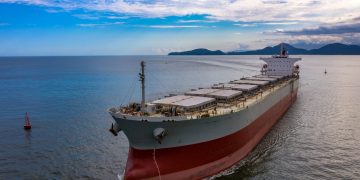Gard P&I Club loss prevention advice
The Gard P&I Club has issued loss prevention circular identifying the dangers of working at heights below deck.
A recent fatality as a result of a fall inside a ship’s cargo tank illustrates the need for better risk assessment before work begins and more safeguards to prevent a fall occurring.
A young seafarer died recently from injuries sustained in a fall during work inside a ship’s cargo tank. He was entering the tank and had just descended the first ladder when he stepped into an open maintenance access in the stringer plate and fell almost 20 meters onto the tank top.
A thorough investigation was carried out and concluded that the accident could have been prevented if the open maintenance access had been identified as a hazard and properly secured before the work began.
The investigation also highlighted other contributory factors common for this type of accidents, such as poor planning and supervision. A permit to work (PWT) had been issued for the specific tank and the open maintenance access was mentioned during the crew’s morning safety meeting, but no order was given to secure the opening.
No proper ‘Tool-box Talk’ was carried out by the assigned work team and the unsecured opening was therefore not discussed as a hazard before the work began. In addition, the tank area was poorly lit and the work team had to use their flashlights to move around.
The most obvious risk is not always the cause of the accident
Falling from a height onboard ships continue to be a cause of death and injury to seafarers despite the maritime industry’s efforts to ensure safe working conditions for the crew. Gard’s case database contains many examples of similar accidents, often with the primary cause of the accident identified as “not following safety management procedures” or “failure of the PTW system”.
Cases illustrate that the procedure for hazard identification and the implementation of safeguards to control risks are not always taken seriously and are looked upon merely as a paper exercise.
Onboard a ship, the termworking at height is normally associated with working aloft, e.g. in a ship’s mast or crane, or outboard where the most obvious risk to somebody is that of falling. But when planning work inside ships’ tanks or other enclosed spaces, most of the focus is on the risks associated with the tank’s atmosphere upon entry.1Less attention is therefore paid to safeguards that can prevent or reduce the possibility of a fall, when in reality the risk of falling in such spaces can be much higher than when working on or above deck.
Enclosed spaces may have hatchways that are difficult to squeeze through, vertical ladders for ascending and descending, slippery decks/surfaces and rungs of the ladders, structural arrangements and pipework acting as trip hazards as well as a work environment that may be humid and uncomfortable.
Rules and regulations
It is a general health and safety requirement that risks associated with all work tasks onboard a ship must be assessed beforehand. This requirement is regulated internationally by the International Safety Management (ISM) Code and the Maritime Labour Convention (MLC) and enforced through the legislation of each flag State. But international maritime regulations contain few ‘hands-on’ design requirements aimed at preventing falls from a height during activities on board.
SOLAS Reg.II-1/3.6 sets out some requirements related to the arrangement of accesses and protection of walkways during close-up inspections of tanks and holds – but only for oil tankers and bulk carriers. The IMO’s “Revised recommendations for entering enclosed spaces aboard ships” does not mention the risk of falling at all.
To ensure a practical approach and uniform enforcement of regulations governing health and safety risks, flag States publish useful codes of working practice (or similar documents). One such example is the UK “Code of Safe Working Practices for Merchant Seamen” (COSWP). Its aim is to provide guidance to shipowners and seafarers on how to fulfil their statutory obligations. The ILO’s “Code of practice for accident prevention on board ship at sea and in port” provides similar practical recommendations and guidance – much of which have been taken from national codes of practice and other safety-related publications.2
How to prevent falls from a height
Operators should ensure work tasks are properly planned, supervised and carried out by competent personnel. Occupational health and safety requirements enforced through flag States’ laws and guidance documents should be carefully adhered to when deciding upon the type of equipment and safeguards to be used for each work task. The following is particularly important to prevent falls from a height
|
|
Although shipowners and operators have a duty to put regulations for the reduction of occupational health and safety risks into practice – each crew member has an obligation to comply with the specific standards and policies applicable on board their ship. Crew members must take reasonable care of their own safety and that of others on board that may be affected by their activities.
Source: The Gard P&I Club


































































